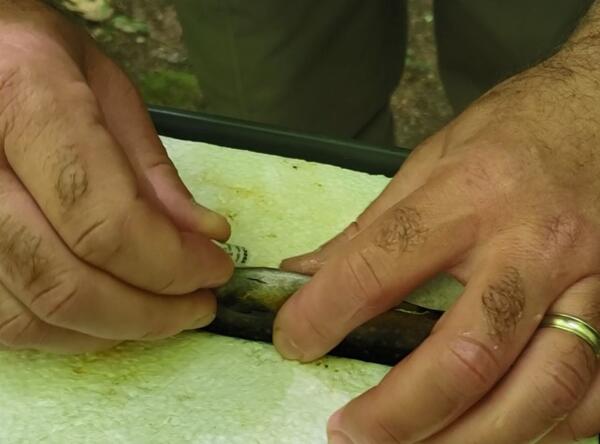Anthropogenic factors coupled with increased stochastic weather events (e.g., flood and drought) has caused stream temperatures to increase. Due largely to increased stream temperature, brook trout currently occupy only 70% of their historical distribution and regional models predict further range contraction as stream temperatures continue to increase.
Matthew O'Donnell
Matt is a Research Ecologist at the USGS Eastern Ecological Science Center at the S. O. Conte Research Laboratory in Turners Falls, MA.
Matt's research focuses on factors that influence population persistence of stream salmonids. In particular, Matt is examining the importance of coldwater refugia, thermal acclimation, and adaptation as a possible mechanisms for brook trout to persist in warming streams. In the field, he leads a project where wild brook trout are implanted with temperature recording tags to determine what water temperature fish actually experience. In the lab, he leads experiments where brook trout are being reared under ambient and increased thermal regimes for successive generations to examine the potential scope for thermal acclimation within generations and adaptation across generations.
Professional Experience
2018-present: Research Ecologist, USGS, Leetown Science Center, Conte Anadromous Fish Research Lab, Turners Falls, Massachusetts
2002-2018: Ecologist, USGS, Leetown Science Center, Conte Anadromous Fish Research Lab, Turners Falls, Massachusetts
2000-2002: Marine Resource Scientist I, Maine Department of Marine Resources, Hallowell, Maine
1999-2000: Biologist I, Mass Wildlife, Westborough, Massachusetts
Education and Certifications
M.S. Fisheries Conservation, UMASS-Amherst, 2000.
B.S. Wildlife and Fisheries Biology and Management, Fisheries option, UMASS-Amherst, 1995.
Science and Products
Understanding Brook Trout Persistence in Warming Streams
Data for examining thermal equilibration rates of brook trout implanted with temperature recording tags and subjected to rapid and slow temperature changes

Anthropogenic factors coupled with increased stochastic weather events (e.g., flood and drought) has caused stream temperatures to increase. Due largely to increased stream temperature, brook trout currently occupy only 70% of their historical distribution and regional models predict further range contraction as stream temperatures continue to increase.
River channel response to the removal of the Pilchuck River Diversion Dam, Washington State
Thermal transfer rate is slower in bigger fish: How does body size affect response time of small, implantable temperature recording tags?
Relating absolute abundance of an estuarine fish to habitat area in an urbanizing environment
Identifying mechanisms underlying individual body size increases in a changing, highly seasonal environment: The growing trout of West Brook
Testing assumptions in the use of PIT tags to study movement of Plethodon salamanders
Cohort strength and body size in co-occurring salmonids in a small stream network: Variation in space and time
How repeatable is CTmax within individual brook trout over short- and long-time intervals?
Survival and density of a dominant fish species across a gradient of urbanization in North Carolina tidal creeks
Daily estimates reveal fine-scale temporal and spatial variation in fish survival across a stream network
Three visualization approaches for communicating and exploring PIT tag data
Implanting 8-mm passive integrated transponder tags into small Brook Trout: Effects on growth and survival in the laboratory
Keeping things local: Subpopulation Nb and Ne in a stream network with partial barriers to fish migration
Non-USGS Publications**
**Disclaimer: The views expressed in Non-USGS publications are those of the author and do not represent the views of the USGS, Department of the Interior, or the U.S. Government.
Science and Products
Understanding Brook Trout Persistence in Warming Streams
Data for examining thermal equilibration rates of brook trout implanted with temperature recording tags and subjected to rapid and slow temperature changes

Anthropogenic factors coupled with increased stochastic weather events (e.g., flood and drought) has caused stream temperatures to increase. Due largely to increased stream temperature, brook trout currently occupy only 70% of their historical distribution and regional models predict further range contraction as stream temperatures continue to increase.
Anthropogenic factors coupled with increased stochastic weather events (e.g., flood and drought) has caused stream temperatures to increase. Due largely to increased stream temperature, brook trout currently occupy only 70% of their historical distribution and regional models predict further range contraction as stream temperatures continue to increase.
River channel response to the removal of the Pilchuck River Diversion Dam, Washington State
Thermal transfer rate is slower in bigger fish: How does body size affect response time of small, implantable temperature recording tags?
Relating absolute abundance of an estuarine fish to habitat area in an urbanizing environment
Identifying mechanisms underlying individual body size increases in a changing, highly seasonal environment: The growing trout of West Brook
Testing assumptions in the use of PIT tags to study movement of Plethodon salamanders
Cohort strength and body size in co-occurring salmonids in a small stream network: Variation in space and time
How repeatable is CTmax within individual brook trout over short- and long-time intervals?
Survival and density of a dominant fish species across a gradient of urbanization in North Carolina tidal creeks
Daily estimates reveal fine-scale temporal and spatial variation in fish survival across a stream network
Three visualization approaches for communicating and exploring PIT tag data
Implanting 8-mm passive integrated transponder tags into small Brook Trout: Effects on growth and survival in the laboratory
Keeping things local: Subpopulation Nb and Ne in a stream network with partial barriers to fish migration
Non-USGS Publications**
**Disclaimer: The views expressed in Non-USGS publications are those of the author and do not represent the views of the USGS, Department of the Interior, or the U.S. Government.


